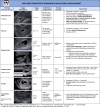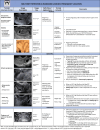A Lexicon for First-Trimester US: Society of Radiologists in Ultrasound Consensus Conference Recommendations
- PMID: 39189906
- PMCID: PMC11366677
- DOI: 10.1148/radiol.240122
A Lexicon for First-Trimester US: Society of Radiologists in Ultrasound Consensus Conference Recommendations
Abstract
The Society of Radiologists in Ultrasound convened a multisociety panel to develop a first-trimester US lexicon based on scientific evidence, societal guidelines, and expert consensus that would be appropriate for imagers, clinicians, and patients. Through a modified Delphi process with consensus of at least 80%, agreement was reached for preferred terms, synonyms, and terms to avoid. An intrauterine pregnancy (IUP) is defined as a pregnancy implanted in a normal location within the uterus. In contrast, an ectopic pregnancy (EP) is any pregnancy implanted in an abnormal location, whether extrauterine or intrauterine, thus categorizing cesarean scar implantations as EPs. The term pregnancy of unknown location is used in the setting of a pregnant patient without evidence of a definite or probable IUP or EP at transvaginal US. Since cardiac development is a gradual process and cardiac chambers are not fully formed in the first trimester, the term cardiac activity is recommended in lieu of 'heart motion' or 'heartbeat.' The terms 'living' and 'viable' should also be avoided in the first trimester. 'Pregnancy failure' is replaced by early pregnancy loss (EPL). When paired with various modifiers, EPL is used to describe a pregnancy in the first trimester that may or will not progress, is in the process of expulsion, or has either incompletely or completely passed. © RSNA and Elsevier, 2024 Supplemental material is available for this article. This article is a simultaneous joint publication in Radiology and American Journal of Obstetrics & Gynecology. All rights reserved. The articles are identical except for minor stylistic and spelling differences in keeping with each journal's style. Either version may be used in citing this article. See also the editorial by Scoutt and Norton in this issue.
Conflict of interest statement
Figures



















References
-
- AIUM practice parameter for the performance of standard diagnostic obstetric ultrasound . J Ultrasound Med 2024. ; 43 ( 6 ): E20 – E32 . - PubMed
-
- Doubilet PM, Benson CB, Bourne T, et al. ; Society of Radiologists in Ultrasound Multispecialty Panel on Early First Trimester Diagnosis of Miscarriage and Exclusion of a Viable Intrauterine Pregnancy . Diagnostic criteria for nonviable pregnancy early in the first trimester. N Engl J Med 2013;369(15):1443–1451. - PubMed
-
- Kolte AM , Bernardi LA , Christiansen OB , et al. ; ESHRE Special Interest Group, Early Pregnancy . Terminology for pregnancy loss prior to viability: a consensus statement from the ESHRE early pregnancy special interest group . Hum Reprod 2015. ; 30 ( 3 ): 495 – 498 . - PubMed
Publication types
MeSH terms
LinkOut - more resources
Full Text Sources

